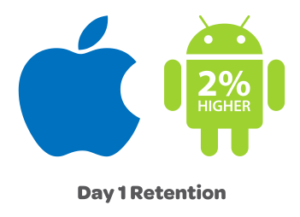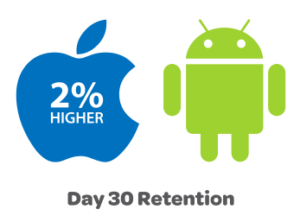The debate between Apple Inc. (NASDAQ:AAPL) iOS and Google Inc. (NASDAQ:GOOG) Android is never ending. Analysts, market observers and tech enthusiasts have always drawn comparison between the two smartphone operating systems and brought out some exciting results. In March 2014, it was established that although engagement and retention of both the OS was almost same, Apple was able to generate more revenue from its iOS.
Apple users are willing to shell out more money for their apps compared to Android users, as recorded in The Swrve Mobile OS Report –iOS vs Android: Engagement, Retention & Monetization in Mobile Apps, May 2014. Mobile marketing company Swrve focused on the three basic app parameters to illustrate contrast-engagement, retention and monetization.
32% More ‘Pay’ Users On iOS Than Android
The Cupertino-giant generates 45% more revenue per iOS user than Google Inc. (NASDAQ:GOOG) does from Android, and 10% more iOS users are likely to make in-app purchases. This can be attributed to the so-called socio-economic divide between Apple and Android users. It is noteworthy here that this data pertains only to the in-app purchases and not advertising or loyalties generated by app. In Q1 2014, although Google Play Store recorded 45% more downloads than iOS App Store, the revenue generated by the latter exceeded the former by 85% and China played a key part in this. The saving grace for Android revenue mostly comes from United States and United Kingdom.
Most of the revenue generated by both the operating systems comes from in-app purchases and freemium business model, where the basic services are free but you have to pay to unlock premium services. These models are responsible for generating more revenue than the basic paid model. Android apps generated 98% more earning through the freemium model. A news by AppleInsider also brought to light that against each $1 revenue earned by iOS app developers, Android app developers generated just $0.19 as revenue.
Android Users More Engaged But Not Loyal !
Android and iOS users have almost the same engagement rate with iOS session length exceeding that of Android by just 1%. The engagement by any app takes into account the average session length – the length of time a user uses the app – and the total number of sessions per user in a month. Considering the latter, Android users have 18% more sessions per month, and therefore, spending 17% more time on their apps. Android users are more likely to remain loyal to their few favourite apps but this is contradicted by the retention capacity of both the operating systems.
The less retention capacity of an app results in wastage of development and acquisition time. Although iOS users tend to stay longer with an app, but it’s a draw between the retention capacities. Android users hold on to their apps 2% longer than the iOS users for 24 hours. But for longer duration, say 30 days, this retention capacity fades away as iOS users tend to remain 2% more loyal to their apps.
It is worth taking a note that ad revenue generated from Android is greater but due to better UI interface of Apple and customer satisfaction, loyalty of iOS users is higher thus generating more revenue. Android users download more apps but they discard them sooner too.
All above findings are based on real data collected from millions of users across dozens of apps by Swrve – a leading mobile marketing company. Only identical or near-identical iOS and Android versions and fraud filter technology is used. The data reflects only the month of March, 2014.





This is complete understated lie. AAL retention is over 80% and revenue is similar over Android use; who buy nothing and largely don’t even know how to use the features on a smartphone. Not to mention most don’t have a credit card.